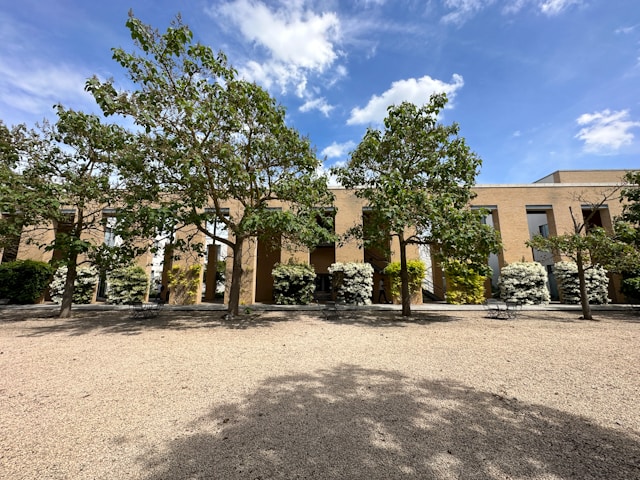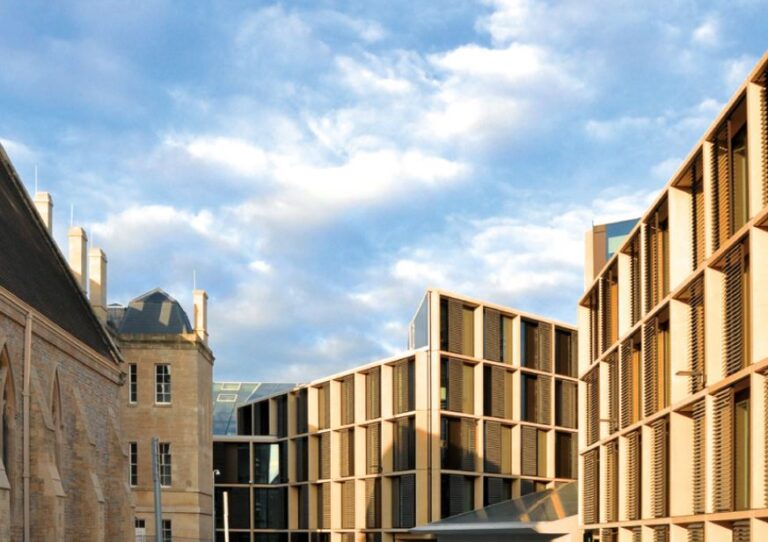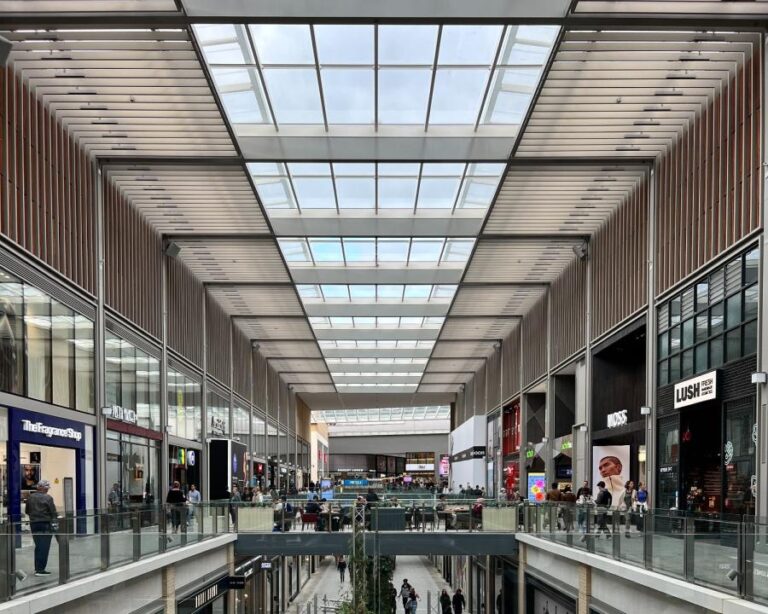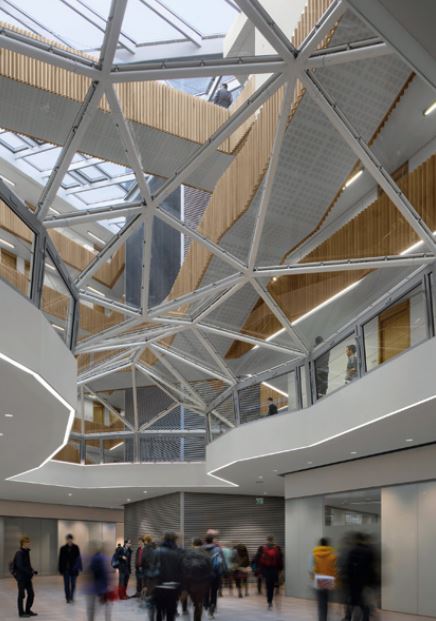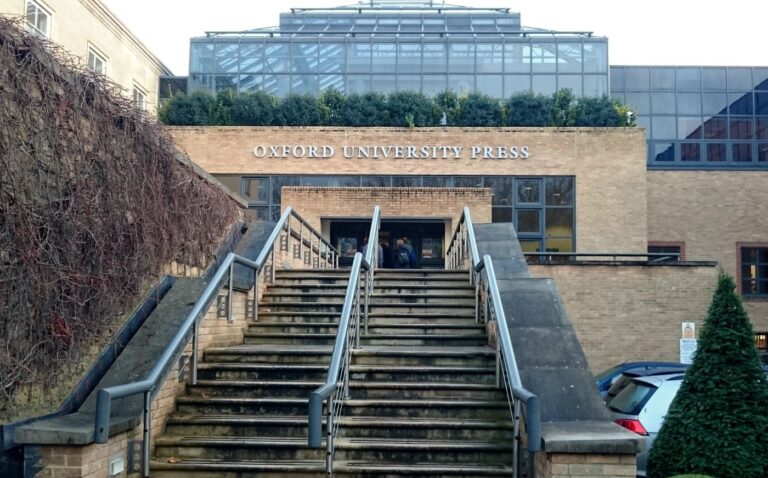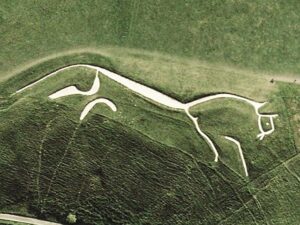Oxford is known for its rich history and stunning architecture, but it also boasts several modern buildings that are definitely worth seeing if you are visiting the city and have an interest in architecture. Below, you will find five examples of modern buildings that contribute to Oxford’s dynamic architectural landscape.
Whether you’re interested in cutting-edge design, academic innovation, or vibrant urban spaces, Oxford has something to offer for every architectural enthusiast. So, let’s take a look at the best and most noteworty modern buildings Oxford has to offer.
#1: The Mathematical Institute, University of Oxford
The Mathematical Institute at the University of Oxford is an architectural gem that stands out amidst the historic surroundings of the university campus. Designed by the internationally acclaimed architect Rafael Viñoly, the building is a striking example of modern architecture that seamlessly integrates with its historic context while making a bold statement of its own.
One of the most distinctive features of the Mathematical Institute is its curved glass façade, which wraps around the building in a sweeping arc. This innovative design not only creates a visually striking impression but also serves a functional purpose by allowing natural light to flood the interior spaces. The transparent façade also provides panoramic views of the surrounding landscape, connecting the building with its environment and fostering a sense of openness and transparency.
The use of glass and steel in the construction of the Mathematical Institute lends the building a sleek and contemporary aesthetic that contrasts with the traditional stone architecture of many other buildings in Oxford. The interplay between light and materials creates dynamic patterns and reflections that change throughout the day, adding an element of visual interest to the building’s exterior.
Inside, the Mathematical Institute is designed to facilitate collaboration and interaction among students and faculty. The building features flexible, open-plan spaces that can be easily configured to accommodate a variety of teaching, research, and social activities.
#2: Westgate Oxford
Designed by renowned architecture firm BDP, Westgate Oxford blends seamlessly with its historic surroundings while making a bold architectural statement of its own.
One of the most notable features of this development is its sleek and contemporary design, characterized by clean lines, glass facades, and open-air walkways. The architecture reflects a modern aesthetic that harmonizes with the traditional stone buildings that define Oxford’s cityscape, creating a seamless transition between old and new.
The exterior of Westgate Oxford is defined by its glass facades, which allow natural light to flood the interior spaces and create a bright and inviting atmosphere for shoppers and visitors. The use of glass also provides panoramic views of the surrounding cityscape, offering glimpses of historic landmarks such as Oxford’s dreaming spires and the scenic River Thames.
Inside, Westgate Oxford features a spacious and airy interior with soaring ceilings, wide walkways, and contemporary design elements. The layout of the complex is designed to maximize flow and circulation, with clear sightlines and intuitive wayfinding to guide visitors through the various retail, dining, and entertainment spaces.
The architecture of Westgate Oxford also prioritizes sustainability and environmental responsibility. The complex incorporates green building principles such as energy-efficient lighting, natural ventilation, and eco-friendly materials to minimize its environmental impact and enhance the well-being of its occupants.
#3: Saïd Business School
The Saïd Business School at the University of Oxford is a modern architectural marvel that embodies innovation, collaboration, and academic excellence. Designed by the esteemed architectural firm Dixon Jones, the building stands as a striking example of contemporary design amidst the historic surroundings of Oxford.
One of the most distinctive features of the Saïd Business School is its bold and innovative architectural design, which blends seamlessly with its historic context while making a bold statement of its own. The building features a sleek and minimalist exterior with clean lines, geometric shapes, and a combination of glass, steel, and stone materials. The modern aesthetic of the building reflects the forward-thinking ethos of the business school and its commitment to pushing the boundaries of knowledge and innovation.
The interior of the Saïd Business School is equally impressive, with spacious and light-filled atriums, state-of-the-art classrooms, and flexible meeting spaces that foster collaboration and interaction among students, faculty, and visitors. The building is designed to promote an open and inclusive environment, with transparent partitions, communal areas, and informal meeting spaces that encourage spontaneous interactions and idea sharing.
Overall, the Saïd Business School at the University of Oxford is a shining example of modern architecture that combines aesthetic appeal with functionality and sustainability.
#4: The Queen's College, Andrew Wiles Building
The Queen’s College, Andrew Wiles Building, located in the heart of Oxford, is a modern architectural masterpiece that seamlessly blends tradition with innovation. Designed by the esteemed architectural firm van Heyningen and Haward, the building stands as a testament to the college’s commitment to excellence in education and research.
The Andrew Wiles Building’s contemporary design, which serves as a striking contrast to the historic architecture that defines much of Oxford’s cityscape. The building’s sleek lines, geometric shapes, and modern materials create a bold and distinctive aesthetic that sets it apart from its surroundings while still respecting the traditional character of the college.
The exterior of the Andrew Wiles Building features a combination of glass, steel, and stone, with a minimalist colour palette that emphasizes its clean and timeless design. Large windows and transparent facades allow natural light to flood the interior spaces, creating a bright and inviting atmosphere for students, faculty, and visitors.
Inside, the Andrew Wiles Building is equally impressive, with state-of-the-art facilities and amenities designed to support the college’s academic and research endeavours. The building houses lecture theatres, seminar rooms, and study spaces equipped with the latest technology and multimedia capabilities, providing students with the tools they need to excel in their studies.
One of the most notable features of the Andrew Wiles Building is its central courtyard, which serves as a focal point for the college community. Surrounded by glass walls and overlooked by balconies, and walkways, the courtyard provides a tranquil oasis where students and faculty can gather, socialize, and relax amidst the hustle and bustle of campus life.
Overall, the Queen’s College, Andrew Wiles Building is a shining example of modern architecture that combines aesthetic appeal with functionality and sustainability. With its bold design, innovative features, and commitment to excellence, the building embodies the spirit of academic achievement and intellectual inquiry that defines the Queen’s College and the University of Oxford as a whole.
#5: Oxford University Press Building
The Oxford University Press Building, located on Great Clarendon Street in Oxford, is a modern architectural marvel designed by the esteemed architectural firm Fletcher Priest. The building stands as a testament to the rich heritage and innovative spirit of one of the world’s oldest and most prestigious publishing houses.
One of the most notable features of the Oxford University Press Building is its sleek and contemporary design, which contrasts with the traditional stone architecture that characterizes much of Oxford’s cityscape. The building’s façade features clean lines, geometric shapes, and a combination of glass, steel, and stone materials, creating a striking visual impact that captures the essence of modernity and sophistication.
Inside, the Oxford University Press Building boasts state-of-the-art facilities and amenities designed to support the publishing house’s operations and promote collaboration and creativity among its employees. The building houses offices, meeting rooms, and collaborative workspaces equipped with the latest technology and multimedia capabilities, providing a dynamic and inspiring environment for the production and dissemination of knowledge.
In addition to its architectural design, the Oxford University Press Building also incorporates sustainable features and green building principles, including energy-efficient lighting, natural ventilation, and eco-friendly materials. These initiatives reflect the publishing house’s commitment to environmental stewardship and sustainability, aligning with its mission to advance learning, scholarship, and research worldwide.
With its bold design, innovative features, and commitment to excellence, the building stands as a symbol of the enduring legacy and global influence of one of the world’s most respected publishing houses.
